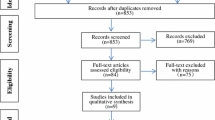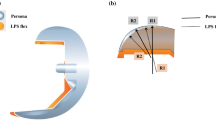Abstract
The present study aimed to examine the results of total knee arthroplasty (TKA) with the NexGen Legacy posterior-stabilized (LPS)-Flex system for osteoarthritis in the valgus knee. Between 2003 and 2011, 27 valgus knees in 26 patients who underwent TKA with the NexGen LPS-Flex implant were clinically and radiologically evaluated after a minimum follow-up of 2 years. The original diagnosis was osteoarthritis. Knee Society Knee Score (KSKS), Knee Society Function Score (KSFS), maximum flexion angle, maximum extension angle, and radiological femorotibial angle (FTA) were evaluated pre- and postoperatively. The mean KSKS improved from 42.6 before surgery to 82.2 by the final follow-up (p < 0.01), and the mean KSFS improved from 41.1 to 80.9 (p < 0.01). The mean maximum flexion angle changed from 109.1° to 117.3° (no statistical significance) and the maximum extension angle improved from −9.7° to −3.6° (p < 0.05) postoperatively. The postoperative radiological FTA was 172.4°, which was closer to a neutral angle (174°) than the preoperative FTA (166.4°) (p < 0.01). None of the patients had undergone revision surgery by the final follow-up. As a conclusion, TKA with the NexGen LPS-Flex implant for osteoarthritis in the valgus knee resulted in satisfactory improvement regarding objective outcomes, although a longer term follow-up with a greater number of cases is necessary to verify these results.

Similar content being viewed by others
References
Anouchi YS, McShane M, Kelly F Jr, Elting J, Stiehl J (1996) Range of motion in total knee replacement. Clin Orthop Relat Res 331:87–92
Kurosaka M, Yoshiya S, Mizuno K, Yamamoto T (2002) Maximizing flexion after total knee arthroplasty: the need and the pitfalls. J Arthroplasty 17:59–62
Ritter MA, Harty LD, Davis KE, Meding JB, Berend ME (2003) Predicting range of motion after total knee arthroplasty. Clustering, log-linear regression, and regression tree analysis. J Bone Joint Surg Am 85A(7):1278–1285
D’Lima DD, Patil S, Steklov N, Colwell CW Jr (2007) An ABJS best paper: dynamic intraoperative ligament balancing for total knee arthroplasty. Clin Orthop Relat Res 463:208–212
Parratte S, Pagnano MW (2008) Instability after total knee arthroplasty. J Bone Joint Surg Am 90(1):184–194
Ranawat AS, Ranawat CS, Elkus M, Rasquinha VJ, Rossi R, Babhulkar S (2005) Total knee arthroplasty for severe valgus deformity. J Bone Joint Surg Am 87:271–284
Aglietti P, Buzzi R, Giron F, Zaccherotti G (1996) The Insall-Burstein posterior stabilized total knee replacement in the valgus knee. Am J Knee Surg 9(1):8–12
Hood RW, Vanni M, Insall JN (1981) The correction of knee alignment in 225 consecutive total condylar knee replacements. Clin Orthop Relat Res 160:94–105
Miyasaka KC, Ranawat CS, Mullaji A (1997) 10- to 20-year followup of total knee arthroplasty for valgus deformities. Clin Orthop Relat Res 345:29–37
Stern SH, Moeckel BH, Insall JN (1991) Total knee arthroplasty in valgus knees. Clin Orthop Relat Res 273:5–8
Insall JN, Dorr LD, Scott RD, Scott WN (1989) Rationale of the knee society clinical rating system. Clin Orthop Relat Res 248:13–14
Li G, Most E, Sultan PG et al (2004) Knee kinematics with a high-flexion posterior stabilized total knee prosthesis: an in vitro robotic experimental investigation. J Bone Joint Surg Am 86A(8):1721–1729
D’Lima DD, Steklov N, Fregly BJ, Banks SA, Colwell CW Jr (2008) In vivo contact stresses during activities of daily living after knee arthroplasty. J Orthop Res 26(12):1549–1555
Sharma A, Komistek RD, Scuderi GR, Cates HE Jr (2007) High-flexion TKA designs: what are their in vivo contact mechanics? Clin Orthop Relat Res 464:117–126
Tarabichi S, Tarabichi Y, Hawari M (2010) Achieving deep flexion after primary total knee arthroplasty. J Arthroplasty 25(2):219–224
Ranawat CS (2003) Design may be counterproductive for optimizing flexion after TKR. Clin Orthop Relat Res 416:174–176
Ritter MA (2006) High-flexion knee designs: more hype than hope? In the affirmative. J Arthroplasty 21:40–41
Sancheti KH, Sancheti PK, Shyam AK, Joshi R, Patil K, Jain A (2013) Factors affecting range of motion in total knee arthroplasty using high flexion prosthesis: a prospective study. Indian J Orthop 47(1):50–56
Bin SI, Nam TS (2007) Early results of high-flex total knee arthroplasty: comparison study at 1 year after surgery. Knee Surg Sports Traumatol Arthrosc 15(4):350–355
Gupta SK, Ranawat AS, Shah V, Zikria BA, Zikria JF, Ranawat CS (2006) The P.F.C. sigma RP-F TKA designed for improved performance: a matched-pair study. Orthopedics 29:S49–S52
Huang HT, Su JY, Wang GJ (2005) The early results of high-flex total knee arthroplasty: a minimum of 2 years of follow-up. J Arthroplasty 20(5):674–679
Choi WC, Lee S, Seong SC, Jung JH, Lee MC (2010) Comparison between standard and high-flexion posterior-stabilized rotating-platform mobile-bearing total knee arthroplasties: a randomized controlled study. J Bone Joint Surg Am 92(16):2634–2642
Kim YH, Sohn KS, Kim JS (2005) Range of motion of standard and high-flexion posterior stabilized total knee prostheses. A prospective, randomized study. J Bone Joint Surg Am 87(7):1470–1475
Nutton RW, van der Linden ML, Rowe PJ, Gaston P, Wade FA (2008) A prospective randomised double-blind study of functional outcome and range of flexion following total knee replacement with the NexGen standard and high flexion components. J Bone Joint Surg Br 90(1):37–42
Murphy M, Journeaux S, Russell T (2009) High-flexion total knee arthroplasty: a systematic review. Int Orthop 33(4):887–893
Krackow KA, Jones MM, Teeny SM, Hungerford DS (1991) Primary total knee arthroplasty in patients with fixed valgus deformity. Clin Orthop Relat Res 273:9–18
Elkus M, Ranawat CS, Rasquinha VJ, Babhulkar S, Rossi R, Ranawat AS (2004) Total knee arthroplasty for severe valgus deformity. Five to fourteen-year follow-up. J Bone Joint Surg Am 86A(12):2671–2676
Nagura T, Dyrby CO, Alexander EJ, Andriacchi TP (2002) Mechanical loads at the knee joint during deep flexion. J Orthop Res 20(4):881–886
Suggs JF, Hanson GR, Park SE, Moynihan AL, Li G (2008) Patient function after a posterior stabilizing total knee arthroplasty: cam-post engagement and knee kinematics. Knee Surg Sports Traumatol Arthrosc 16(3):290–296
Koskinen E, Remes V, Paavolainen P, Harilainen A, Sandelin J, Tallroth K et al (2011) Results of total knee replacement with a cruciate-retaining model for severe valgus deformity-a study of 48 patients followed for an average of 9 years. Knee 18(3):145–150
Idusuyi OB, Morrey BF (1996) Peroneal nerve palsy after total knee arthroplasty. Assessment of predisposing and prognostic factors. J Bone Joint Surg Am 78(2):177–184
Piedade SR, Pinaroli A, Servien E, Neyret P (2009) Revision after early aseptic failures in primary total knee arthroplasty. Knee Surg Sports Traumatol Arthrosc 17(3):248–253
Scuderi GR, Bourne RB, Noble PC, Benjamin JB, Lonner JH, Scott WN (2012) The new knee society knee scoring system. Clin Orthop Relat Res 470(1):3–19
Conflict of interest
The authors declare that they have no conflict of interest.
Author information
Authors and Affiliations
Corresponding author
Rights and permissions
About this article
Cite this article
Nakano, N., Matsumoto, T., Muratsu, H. et al. Results of total knee arthroplasty with NexGen LPS-Flex for osteoarthritis in the valgus knee: a study of 26 patients followed for a minimum of 2 years. Eur J Orthop Surg Traumatol 25, 375–380 (2015). https://doi.org/10.1007/s00590-014-1505-1
Received:
Accepted:
Published:
Issue Date:
DOI: https://doi.org/10.1007/s00590-014-1505-1




